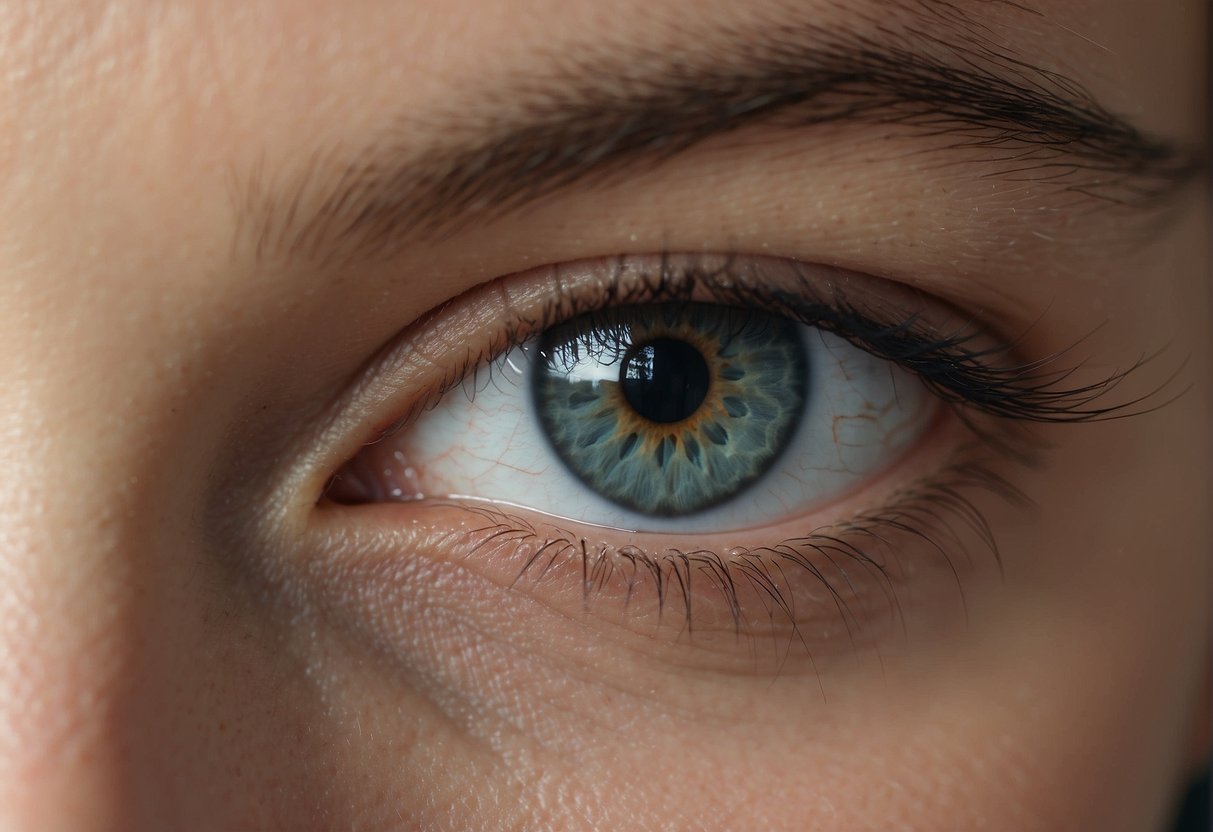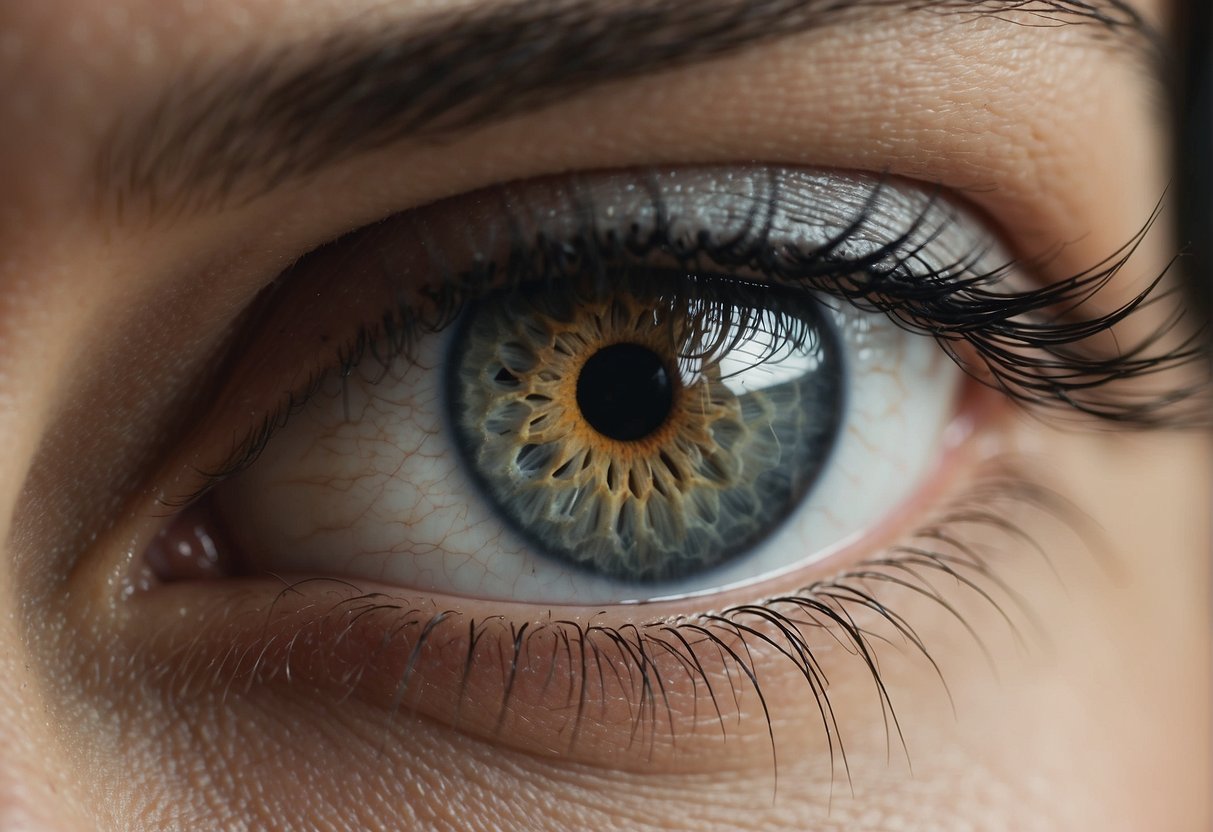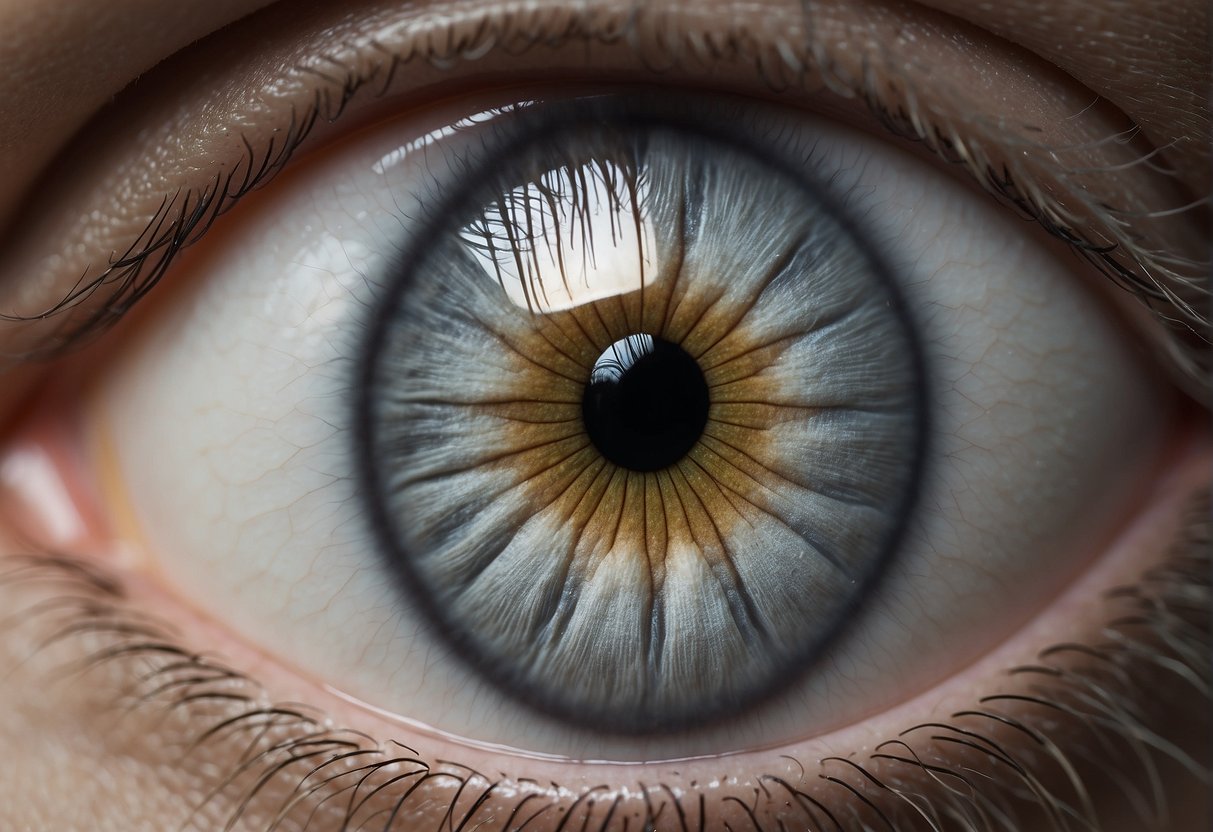
Grey Eyes: Unraveling the Genetics of a Rare Eye Color
Posted by Team Debby on 9th Jan 2024
Grey Eyes: Unraveling the Genetics of a Rare Eye Color
Grey eyes are one of the rarest eye colors found in humans, and their intriguing appearance often captures people's attention.
Eye color is a genetic trait that is determined by the distribution and amount of melanin in the iris, coupled with the way light scatters in the iris. This scattering is known as Rayleigh scattering, and it is the same physical principle that makes the sky look blue.
People with grey eyes have even less melanin in their irises than those with blue eyes. This results in a subdued and sometimes steely hue that can vary from light to dark grey.

Our fascination with grey eyes is not merely due to their rarity. It extends into how they seem to change color in different lighting conditions or reflect certain moods and emotions.
Unlike other more common eye colors, the understated charm of grey eyes can be quite potent. They can appear mystical or piercing, and this unique quality often sets them apart as a striking feature in an individual’s appearance.
The allure of grey eyes can be attributed to their ambiguity. They do not present a clear color, rather a spectrum that combines the lightness of blue eyes with the depth of green or the strength of hazel.
In our exploration of eye color, we often find that grey eyes remain enigmatic. They dance between different tones and shades based on the environment and lighting.
This versatility makes grey eyes a point of endless fascination and a hallmark of complexity in human appearance.
Genetics Behind Grey Eyes

Grey eyes are a rare and intriguing trait, resulting from a complex interplay of genetics and the distribution of melanin in the iris.
Inheritance Patterns
We observe that eye color is a polygenic trait, which means it's determined by the influence of multiple genes rather than a single gene.
The inheritance pattern of grey eyes is not as straightforward as simpler Mendelian genetics. It's an example of incomplete dominance, where the phenotypic expression of grey eyes tends to be variable and can exhibit a range of intensities.
Relevant Genes
When we examine the genetic basis for grey eyes, two genes stand out as particularly influential: the OCA2 gene and the HERC2 gene.
The OCA2 gene on chromosome 15 has a significant impact on pigment production. Variations in this gene can reduce melanin in the iris, leading to lighter eye colors, including grey.
HERC2 gene interacts with OCA2 and can influence its expression.
Another gene that deserves attention is SLC24A4. Our research indicates that this gene is involved in the transportation of ions that can affect pigmentation in the eye.
Lastly, the TYR gene is associated with the enzyme tyrosinase. It plays a role in melanin synthesis, though its direct influence on grey eyes is less clear compared to brown or blue eyes.
Physical Characteristics of Grey Eyes

Grey eyes are a captivating ocular feature, often appearing as a spectrum of hues from silver to blue-grey. They owe their color primarily to melanin content and the architectural complexity of the iris.
Melanin Content
We understand that melanin plays a pivotal role in eye color. In grey eyes, the melanin content is lower than that of brown eyes yet higher than blue eyes.
This distinction arises from the distribution and density of melanoproteins within the iris's melanocytes, which influences light absorption and scattering.
Grey eyes typically possess a balance of the two types of melanin found in human eyes:
- Eumelanin: Dominantly responsible for darker shades in the iris.
- Pheomelanin: Contributes to lighter hues such as red and yellow.
| Melanin Type | Presence in Grey Eyes |
|---|---|
| Eumelanin | Moderate |
| Pheomelanin | Low to Moderate |
Iris Structure
Our iris consists of two layers: the front (stroma) and the back (pigmented epithelium). Grey eyes manifest their unique color primarily through the structure and the low melanin concentration in the stroma layer.
Notably, grey eyes may exhibit a 'fibrous' look due to:
- Iris Stromal Architecture: Collagen fibers within the stroma can scatter the incoming light, a phenomenon which contributes to the grey appearance.
- Light and Dark Contrasts: The variation of lighter and darker areas within the stroma is more pronounced with age. This influences the perceived color tone of grey eyes.
Variations in Grey Eye Color

Grey eye color exhibits a spectrum of shades and is often influenced by other hues, making it a distinctive feature in individuals.
Shades and Hues
- Darker Grey: Often this shade can appear to be a steely hue, closer to charcoal. At times, it may have a blueish tint.
- Light Grey: This is a more silvery shade which can sometimes seem almost translucent. It can have flecks of gold or brown.
In our observation, no two pairs of grey eyes are exactly alike. Varying degrees of light and the presence of other pigments can affect the perception of this iris color.
Other Eye Colors Association
- With Blue Eyes: Grey eyes sometimes contain elements of blue, and it's common for individuals to have a mix of blue and grey hues in their irises. It's also worth noting that both blue and grey eyes have low levels of melanin.
- Green and Hazel Tones: Green or hazel eyes might share some commonalities with grey eyes, especially around the edges or in the form of streaks or flecks within the grey. These combinations are less common and are often considered among the rarest eye colors.
Our examination shows that the interplay between grey and these other colors results in a captivating array of iris colorations, unique to each individual.
Global Distribution and Demographics

Grey eyes are a rare occurrence worldwide, with estimates suggesting less than 1% of the global population possess this eye color.
We observe that Europe has the highest concentration of individuals with grey eyes, particularly in regions where lighter eye phenotypes, such as blue and green, are common.
In countries such as Estonia and Finland, a significant portion of the populace display grey-colored eyes due to a greater prevalence of genes associated with this pigment.
In contrast, grey eyes become increasingly uncommon as we move towards Asia and Africa. In these areas, darker eyes dominate, largely because they provide greater protection against intense sunlight and UV radiation.
Grey eyes in these regions might be tied to ancestry or certain genetic mutations that are less prevalent.
Moving to the U.S., the landscape becomes more diverse. Due to the country's history of immigration, the United States is home to a variety of eye colors, including grey, although they are not as widespread as other colors.
Individuals with grey eyes often trace their heritage to European ancestors—evidence of the genetic components at play.
Here's a quick reference on the occurrence of grey eyes in key regions:
- Europe: Estonia, Finland and surrounding countries have notably higher rates of grey eyes.
- Asia & Africa: Very rare, with occurrences largely due to genetic variety or European descent.
- U.S.: Diverse, but grey eyes are less common compared to other colors; typically traced back to European ancestry.
To recap on a regional basis:
- European Ancestry: Dominant factor for grey eyes presence.
- European Descent: Strong influence in global distribution of grey eyes.
- Region: European countries exhibit the highest grey eye frequency.
Health Considerations for Grey Eyes

In discussing grey eyes, it's important for us to consider the unique health implications they may carry. We'll explore both the associated conditions and the specific eye care recommendations for individuals with grey eyes.
Associated Conditions
Ocular Melanoma: Although rare, individuals with lighter eye colors, such as grey, may have a higher risk of developing ocular melanoma. This cancer forms in the melanin-producing cells in the uvea, which can be less pigmented in grey eyes.
- Melanoma: Not to be confused with skin melanoma, ocular melanoma can be a serious condition, albeit less common than other types of cancer.
Photophobia: People with grey eyes often experience a heightened sensitivity to light, known as photophobia. This occurs due to less pigmentation, which can result in more light penetration and discomfort in bright conditions.
- Ocular Albinism: Although not common, ocular albinism can be associated with lighter eye pigmentation, like grey eyes. It includes risks such as vision impairment and photophobia.
Autoimmune Diseases: Research has suggested that there may be a correlation between lighter eye colors and certain autoimmune diseases, although this area continues to be studied for more conclusive evidence.
Eye Care Recommendations
Protection from UV Light: To mitigate the risk of ocular melanoma, we recommend regular use of UV-protective sunglasses. This is particularly crucial for those with grey eyes due to their increased sensitivity to sunlight.
- UV-blocking sunglasses
- Wide-brimmed hats
Manage Photophobia: Since individuals with grey eyes are more susceptible to light sensitivity, strategies for managing photophobia are essential. This includes various forms of light control and possibly wearing tinted lenses to help reduce glare.
- Use of dimmer switches or adjustable lighting
- Anti-reflective coated lenses
Regular Eye Exams: We cannot overstate the importance of regular eye examinations, especially for detecting conditions like glaucoma, which can occur without obvious symptoms early on.
Cultural and Psychological Aspects

Eye color can hold significant cultural and psychological value, shaping perceptions and attributing qualities to individuals.
In our exploration of grey eyes, we observe that they are often surrounded by distinctive cultural narratives and psychological interpretations.
Perceived Attractiveness
Grey eyes are considered rare and distinctive, which can contribute to their allure. A number of studies indicate that eye color can influence how we perceive attractiveness.
Traditionally, people with grey eyes are often seen as enigmatic and appealing due to the uniqueness of this eye color. The scarcity of grey eyes may lead to a perception of exclusivity, enhancing their attractiveness to some.
- Attractiveness Factors:
- Rarity: Grey eyes are less common compared to other eye colors.
- Uniqueness: Associated with a unique aesthetic appeal.
Symbolic Meanings
In our analysis of symbolic representations, we find that grey eyes are often associated with wisdom and a balanced mood.
Culturally, grey can signify neutrality and calmness, and in some literary and artistic depictions, characters with grey eyes are often portrayed as wise beyond their years or as possessing profound knowledge.
- Symbolic Associations:
- Wisdom: Reflective of deep insight or intelligence.
- Mood: Grey eyes can be seen to symbolize stability and a composed temperament.
By examining these aspects, we gain insights into how grey eyes are not just a physical trait but a tapelet of cultural and psychological significance.
Cosmetic and Fashion Choices

In our exploration of gray eyes, we recognize that specific cosmetic and fashion choices can enhance their unique appeal.
We focus on makeup and clothing strategies, as well as contact lens options, tailored to those with gray eyes.
Makeup and Clothing
Choosing the right makeup and clothing colors can accentuate gray eyes, making them a standout feature.
For makeup, we recommend a palette of complementary colors:
- Eyeshadows:
- Blues: Navy or midnight blue to contrast the gray
- Purples: Lilac or plum to add warmth
- Metallics: Silver or pewter to highlight the natural eye shimmer
- Eyeliners:
- Charcoal or dark gray for a subtle definition
- Bold colors like emerald green to make the gray pop
In terms of clothing, certain hues can enhance the appearance of gray eyes:
- Colors that Compliment Gray Eyes:
- Jewel tones like sapphire or emerald
- Neutrals such as gray, black, or navy
- Soft pastels to create a gentle contrast
Pairing these color choices with clothing that suits individual skin and hair tones will bring our entire look together.
Contact Lenses Options
For those wishing to experiment with their eye color, contact lenses are an excellent option. We've outlined some possibilities, including UV-protected types which can provide additional benefits:
- Enhancement Tint: To define the edges of our iris and deepen our natural gray color
- Opaque Tint: For a complete color change, suitable even for dark eyes
- UV-Protected Lenses: To shield our eyes from harmful UV rays, whether in clear prescriptions or tinted varieties
It's important to consult with a professional to find contacts that are safe, comfortable, and complement our overall appearance.
By embracing these cosmetic and fashion choices, we can emphasize our gray eyes effectively, blending style with a touch of personal flair.
Science of Eye Color Determination

We understand that the color of our eyes is largely determined by genetics, specifically dictated by the amount of melanin present in the iris.
This pigmentation ranges from light to dark, and the density of melanin can influence color perception under different lighting conditions.
Gray eyes are less common than other colors, and their unique shade is the result of a particular distribution of melanin and the way light interacts with the eye.
Eye color can change with age; for example, as we grow, melanin concentration may increase, potentially altering the hue of our eyes. In gray eyes, the rarity of this color is partly due to the specific balance of melanin.
When it comes to the science behind the coloration, two types of light scattering are crucial: Rayleigh scattering and Tyndall scattering.
Rayleigh scattering, responsible for the blue color of the sky, also plays a significant part in creating the unique gray shades in eyes. Tyndall scattering is similar, though it's more often observed in other contexts.
We can refer to insights from Duke Health and other scientific studies to illustrate the complexity behind eye color.
The subtleties in gray eye coloration are not only a result of the melanin and scattering phenomena, but they are also influenced by the external environment and the quality of light.
Summary of Key Factors:
- Melanin Concentration: Dictates the primary coloration of the iris.
- Lighting Conditions: Affect how we perceive eye color.
- Age: Can influence melanin density and, thus, eye color over time.
- Rayleigh Scattering: Contributes to the specific shade of gray.
- Rarity: Gray eyes are relatively rare compared to other colors.
Frequently Asked Questions

In this section, we cover some of the most commonly asked questions about grey eyes, exploring genetics, rarity, and potential environmental influences.
What determines the color of grey eyes?
The color of grey eyes is determined by the amount of melanin in the iris and how it's distributed. Low melanin levels and light scattering in the stroma of the iris give grey eyes their distinct hue.
How rare are grey eyes compared to other eye colors?
Grey eyes are among the rarest eye colors, more uncommon than blue or brown. They are often found in Eastern and Northern European populations but are less prevalent globally.
Can environmental factors influence the appearance of grey eyes?
Yes, environmental factors like lighting can impact how we perceive eye color, causing grey eyes to appear different under various light conditions. However, these factors do not change the actual eye color.
What genetic factors contribute to someone having grey eyes?
It's a complex interaction of multiple genes that contributes to having grey eyes, including but not limited to the OCA2 and HERC2 genes. Genetic variation in these genes can lead to less melanin production in the iris, resulting in grey eyes.
Is there a connection between personality traits and having grey eyes?
There is no scientific evidence to support a direct correlation between grey eyes and specific personality traits. Such associations are purely anecdotal and not based on genetic science.
How can you differentiate between blue and grey eye colors?
Differentiating between blue and grey eyes involves looking at the shade and intensity.
Blue eyes typically have a more vibrant, ocean-like color, while grey eyes tend to have a steely or smoky appearance that lacks the deeper blue hue.

